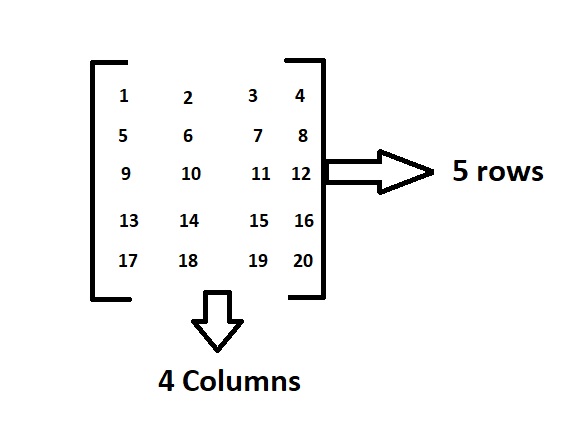In the previous article, we have discussed Python Program for Sum of Middle Row and Column in Matrix
Markov Matrix:
The matrix where the sum of each row equals one.
Given a matrix, the task is to check if the given matrix is a Markov matrix or not.
What is a matrix:
A matrix is a rectangular sequence of numbers divided into columns and rows. A matrix element or entry is a number that appears in a matrix.
Example:

Above is the matrix which contains 5 rows and 4 columns and having elements from 1 to 20.
In this order, the dimensions of a matrix indicate the number of rows and columns.
Examples:
Example1:
Input:
Given Matrix : 0.5 0.5 0 0 0 1 1 0 0
Output:
Yes, the given matrix is a Markov Matrix
Example2:
Input:
Given Matrix : 1 2 0 0 0.5 0.5 1 0 0
Output:
No, the given matrix is not a Markov Matrix
Program for Markov Matrix in Python
Below are the ways to check if the given matrix is a Markov matrix or not in python:
Method #1: Using For Loop (Static Input)
Approach:
- Give the matrix as static input and store it in a variable.
- Calculate the number of rows of the given matrix by calculating the length of the nested list using the len() function and store it in a variable mtrxrows.
- Calculate the number of columns of the given matrix by calculating the length of the first list in the nested list using the len() function and store it in a variable mtrxcolums.
- Pass the given matrix as an argument to the chek_Markovmatrix function and check if the function returns true or false using the if conditional statement.
- If it is true then print “Yes, the given matrix is a Markov Matrix”.
- Else print “No, the given matrix is not a Markov Matrix”.
- Create a function to say chek_Markovmatrix which takes the given matrix as an argument and returns True or false.
- Loop till the given number of rows using the For loop.
- Take a variable to say row_summ and initialize its value to 0.
- Inside the For loop, Iterate till the given number of rows using another Nested For loop(Inner For loop).
- Add mtrx[p][q] to the above row_summ (where p is the iterator value of the parent for loop and q is the iterator value of the inner forloop).
- Store it in the same variable row_summ
- Check if the value of row_summ is not equal to 1 using the if conditional statement.
- If it is true then return false.
- Return True.
- The Exit of the Program.
Below is the implementation:
# Create a function to say chek_Markovmatrix which takes the given matrix as an argument
# and returns True or false.
def chek_Markovmatrix(mtrx):
# Loop till the given number of rows using the For loop.
for p in range(mtrxrows):
# Take a variable to say row_summ and initialize its value to 0.
row_summ = 0
# Inside the For loop, Iterate till the given number of rows using another Nested
# For loop (Inner For loop).
for q in range(mtrxrows):
# Add mtrx[p][q] to the above row_summ (where p is the iterator value of the
# parent for loop and q is the iterator value of the inner forloop).
# Store it in the same variable row_summ
row_summ = row_summ + mtrx[p][q]
# Check if the value of row_summ is not equal to 1 using the if conditional
# statement.
if (row_summ != 1):
# If it is true then return false.
return False
# Return True.
return True
# Give the matrix as static input and store it in a variable.
mtrx = [[0.5, 0.5, 0], [0, 0, 1], [1, 0, 0]]
# Calculate the number of rows of the given matrix by
# calculating the length of the nested list using the len() function
# and store it in a variable mtrxrows.
mtrxrows = len(mtrx)
# Calculate the number of columns of the given matrix by
# calculating the length of the first list in the nested list
# using the len() function and store it in a variable mtrxcols.
mtrxcols = len(mtrx[0])
# Pass the given matrix as an argument to the chek_Markovmatrix function and check if
# the function returns true or false using the if conditional statement.
if (chek_Markovmatrix(mtrx)):
# If it is true then print "Yes, the given matrix is a Markov Matrix".
print("Yes, the given matrix is a Markov Matrix")
else:
# Else print "No, the given matrix is not a Markov Matrix".
print("No, the given matrix is not a Markov Matrix")
Output:
Yes, the given matrix is a Markov Matrix
Method #2: Using For loop (User Input)
Approach:
- Give the number of rows of the matrix as user input using the int(input()) function and store it in a variable.
- Give the number of columns of the matrix as user input using the int(input()) function and store it in another variable.
- Take a list and initialize it with an empty value using [] or list() to say gvnmatrix.
- Loop till the given number of rows using the For loop
- Inside the For loop, give all the row elements of the given Matrix as a list using the list(), map(), float(), split() functions and store it in a variable.
- Add the above row elements list to gvnmatrix using the append() function.
- Pass the given matrix as an argument to the chek_Markovmatrix function and check if the function returns true or false using the if conditional statement.
- If it is true then print “Yes, the given matrix is a Markov Matrix”.
- Else print “No, the given matrix is not a Markov Matrix”.
- Create a function to say chek_Markovmatrix which takes the given matrix as an argument and returns True or false.
- Loop till the given number of rows using the For loop.
- Take a variable to say row_summ and initialize its value to 0.
- Inside the For loop, Iterate till the given number of rows using another Nested For loop(Inner For loop).
- Add mtrx[p][q] to the above row_summ (where p is the iterator value of the parent for loop and q is the iterator value of the inner for loop).
- Store it in the same variable row_summ
- Check if the value of row_summ is not equal to 1 using the if conditional statement.
- If it is true then return false.
- Return True.
- The Exit of the Program.
Below is the implementation:
# Create a function to say chek_Markovmatrix which takes the given matrix as an argument
# and returns True or false.
def chek_Markovmatrix(mtrx):
# Loop till the given number of rows using the For loop.
for p in range(mtrxrows):
# Take a variable to say row_summ and initialize its value to 0.
row_summ = 0
# Inside the For loop, Iterate till the given number of rows using another Nested
# For loop (Inner For loop).
for q in range(mtrxrows):
# Add mtrx[p][q] to the above row_summ (where p is the iterator value of the
# parent for loop and q is the iterator value of the inner forloop).
# Store it in the same variable row_summ
row_summ = row_summ + mtrx[p][q]
# Check if the value of row_summ is not equal to 1 using the if conditional
# statement.
if (row_summ != 1):
# If it is true then return false.
return False
# Return True.
return True
# Give the number of rows of the matrix as user input using the int(input()) function
# and store it in a variable.
mtrxrows = int(input('Enter some random number of rows of the matrix = '))
# Give the number of columns of the matrix as user input using the int(input()) function
# and store it in another variable.
mtrxcols = int(input('Enter some random number of columns of the matrix = '))
# Take a list and initialize it with an empty value using [] or list() to say gvnmatrix.
mtrx = []
# Loop till the given number of rows using the For loop
for n in range(mtrxrows):
# Inside the For loop, Give all the row elements of the given Matrix as a list using
# the list(),map(),float(),split() functions and store it in a variable.
l = list(map(float, input(
'Enter {'+str(mtrxcols)+'} elements of row {'+str(n+1)+'} separated by spaces = ').split()))
# Add the above row elements list to gvnmatrix using the append() function.
mtrx.append(l)
# Pass the given matrix as an argument to the chek_Markovmatrix function and check if
# the function returns true or false using the if conditional statement.
if (chek_Markovmatrix(mtrx)):
# If it is true then print "Yes, the given matrix is a Markov Matrix".
print("Yes, the given matrix is a Markov Matrix")
else:
# Else print "No, the given matrix is not a Markov Matrix".
print("No, the given matrix is not a Markov Matrix")
Output:
Enter some random number of rows of the matrix = 3
Enter some random number of columns of the matrix = 3
Enter {3} elements of row {1} separated by spaces = 1 2 0
Enter {3} elements of row {2} separated by spaces = 0 0.5 0.5
Enter {3} elements of row {3} separated by spaces = 1 0 0
No, the given matrix is not a Markov MatrixAccess the big list of Python Programming Code Examples with actual logical code asked in Programming and Coding Interviews for Python and stand out from the crowd.
